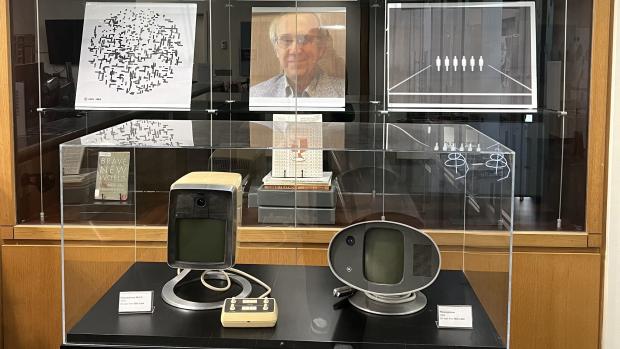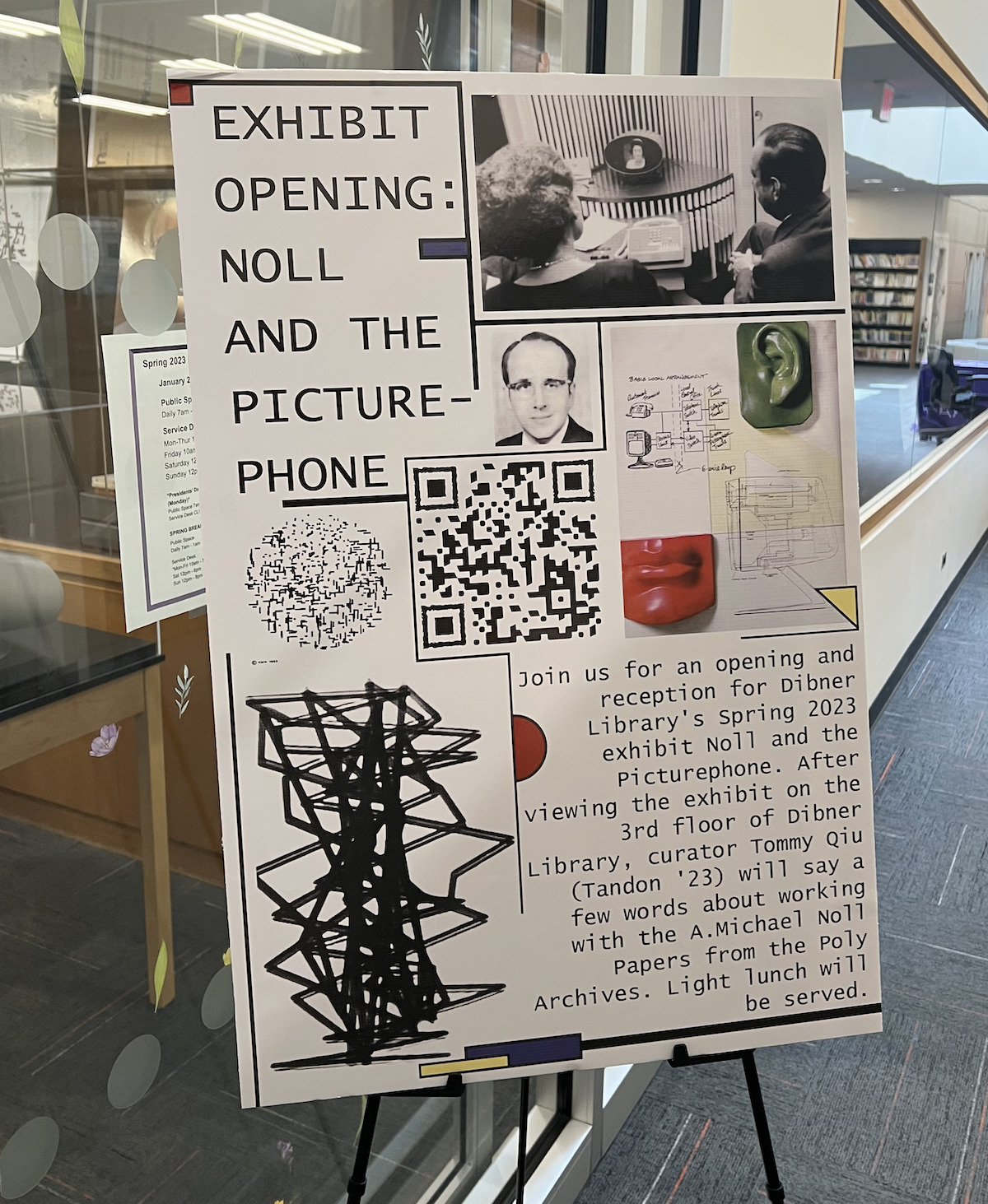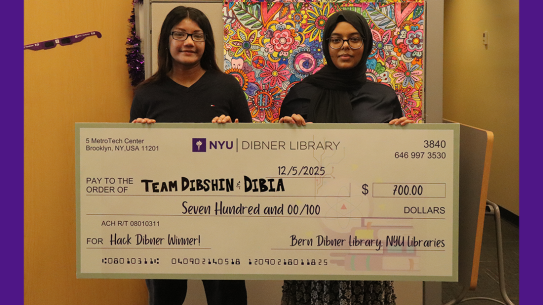Before there was Zoom
An exhibit at Dibner Library looks back at the work of alum A. Michael Noll (‘63, ‘71)

When the producers of the popular 1968 science fiction film 2001: A Space Odyssey envisioned placing a futuristic phonebooth on the set of their orbiting space station, they knew just where to turn. The design for that device, which would transmit an image of the parties at either end of the line, was the brainchild of Bell Labs engineer and NYU Tandon alum A. Michael Noll, who even thought to include an official Bell System seal, which can be seen on the side of the booth in the movie. (That touch caused some consternation after the blockbuster was released, and a sharp-eyed company executive spotted it: legally, the Bell System was restricted to operating domestic telecommunication systems, but the official seal on the prop could, he feared, be viewed as an indication that Bell was now operating in space.)
Now showing in 5 MetroTech
 Computer Science major Tommy Qiu (‘23) became fascinated by these and other stories when he began studying under archivist Lindsay Anderberg at the Bern Dibner Library. Granted access to the library’s Noll collection, he realized the alum’s life and work merited an entire exhibit. “He's a compelling mix of scientist, academic, innovator, artist, journalist and policy advisor,” Qiu says. “His breadth of experience and interests is really noteworthy, and I thought it should be celebrated at the institution where he earned his graduate degrees.” (Before the merger of the two institutions, Noll received a master’s degree in electrical engineering from NYU in 1963, and a doctoral degree from what was then known as Brooklyn Poly in 1971.)
Computer Science major Tommy Qiu (‘23) became fascinated by these and other stories when he began studying under archivist Lindsay Anderberg at the Bern Dibner Library. Granted access to the library’s Noll collection, he realized the alum’s life and work merited an entire exhibit. “He's a compelling mix of scientist, academic, innovator, artist, journalist and policy advisor,” Qiu says. “His breadth of experience and interests is really noteworthy, and I thought it should be celebrated at the institution where he earned his graduate degrees.” (Before the merger of the two institutions, Noll received a master’s degree in electrical engineering from NYU in 1963, and a doctoral degree from what was then known as Brooklyn Poly in 1971.)
The result of Qiu’s work will be on display near the third-floor reception desk of Dibner throughout the summer. Among the most eye-catching elements are two actual “picture phones,” on loan from Bell archivist Ed Eckert. “Being able to see the person on a call is something we take for granted now,” Qiu explains. “Skype, FaceTime, video conference software and similar applications are just a routine part of modern life. However, once upon a time, the idea of a ‘video phone’ was pure science fiction. The notion that we could actually see the person on the other end of the call was like something from The Jetsons.”
When the exhibit opened, prevailing sentiment was that the devices did, in fact, look exactly like the models pictured in the popular 1962 cartoon, which can still be seen in perpetual syndication.
A troubled invention
It’s easy to look at the picture phones on display as simply quaint artifacts of an optimistic, bygone era, but the development process was rife with dissension. Noll — who was a researcher at Bell’s Murray Hill, New Jersey, facility from 1961 to 1971, and then, after a hiatus to serve in the White House Office of Science and Technology, from 1973 to 1983 — is now, in retrospect, considered to have been something of a voice of reason during a heady time when transforming science fiction into reality seemed well within grasp. The overarching problem with this was that the buying public was not quite ready for that reality. With a 15-minute video call costing the equivalent of about $600 in today’s money, the device, which had taken an estimated $500 million to develop, was far from a commercial hit. “The only consumer research was a demonstration at the New York World’s Fair of 1964,” Noll recalled in an autobiographical essay, “and the result was what came to be called ‘the Bell System’s Edsel.’”
The intersection of art, technology, and touch
As Qiu discovered when delving into the archival material, Noll also did seminal work in the realm of computer graphics.
It was in the summer of 1962 that Noll created his first piece of digital art — totally by accident. A colleague’s microfilm plotter had produced an abstract linear design that he found visually compelling, and he subsequently sent a memo to other researchers explaining that he had generated a “series of interesting and novel patterns” on the IBM 7090. Although for years he preferred to call his creations “patterns” rather than “art,” in 1965 a collection of his pieces was displayed at the Howard Wise Gallery in New York City in what is widely acknowledged as the first such exhibit in the U.S. (Reportedly, some Bell executives were displeased, believing that his foray into the art world would lead observers to take the research going on in Murray Hill less seriously.)
During his tenure at Bell, Noll also created some of the world’s earliest 3D, stereoscopic computer-animated clips, and a computer-generated ballet performed by stick figures he devised is now considered a seminal step in the evolution of computer graphics.
At Poly, Noll’s dissertation project involved a system he called “the feelies,” a 3D force-feedback device that enabled users to feel simulated objects such as spheres or cubes. He filed a patent on May 26, 1971, for the device, which some observers consider an early precursor of virtual reality technology.
Life after Bell
Noll’s time at the White House planted a seed in his mind: effectively implementing new technology was reliant on public policy, finance and consumer needs. Government was vital in encouraging innovative work, industry was needed to build practical applications, and consumers actually have to want to use it. He wrote frequently about those issues in both news outlets like the New York Times and scholarly journals like Telecommunications Policy, and he is also the author of multiple telecommunications textbooks.
After leaving Bell, Noll also forged an academic career that found him teaching a graduate-level course in telecommunication technology and systems at NYU Tisch and serving as a Senior Affiliated Research Fellow at the Columbia Institute for Tele-Information (CITI) at Columbia University's Business School, a Research Affiliate of the Quello Center at Michigan State University, an Affiliated Scholar at the Communications Media Center at the New York Law School, and Dean of the Annenberg School at the University of Southern California.
“To me, the most exciting thing about this project is the connections that were made,” Anderberg says. “Tommy’s archival research led him to an interview with an NYU/Poly alumnus and interactions with Bell Labs archivists and IEEE historians. His work not only activates the Poly Archives, but affirms how strong undergraduate research can be if given the proper support.”
“Tandon graduates have been involved in some of the most innovative tech projects imaginable, as this exhibit on A. Michael Noll proves,” says Dean Jelena Kovačević. “It was especially fascinating to me because I, myself, was a researcher at Bell Labs in Murray Hill from 1991 to 2002, and while I can’t say I worked on anything quite as cool as a picture phone, it was a wonderful time and place to conduct research. Tommy did a great job curating the exhibit, and I know anyone who sees it will learn something new.”
In Noll's words...
In the 1950s and 1960s, Bell Telephone Laboratories, Inc. (Bell Labs) offered an educational program called Communication Development Training Program (CDTP). It was nicknamed “Kelly College” after Bell Labs president Dr. Mervin J. Kelly, who invented the program. The program was a powerful way of attracting the top engineering undergraduates to Bell Labs by offering a masters degree, fully paid by Bell Labs. New engineering hires spent their first two years in the program taking courses at the Murray Hill, NJ facility. Engineering faculty from New York University (NYU) was bused to Murray Hill, NJ to teach the courses. The graduates received an M.E.E. degree (Master in Electrical Engineering) from NYU. Those in the program spent a summer as an intern in a different area of Bell Labs other than their home department. This was done to offer a broadened experience. The NYU faculty teaching the courses had a theoretical approach to the material they taught. It was not practical engineering. I was not a theoretician and had challenges with many of the courses, but I did earn my degree in the end. For my doctorate, I wanted a more practical approach to engineering, along with the ability to study and take courses on a part-time basis. The Polytechnic Institute of Brooklyn (Brooklyn Poly) offered all that; I enrolled there, and earned a Ph.D. (E.E.) in 1971.
A. Michael Noll
October 5, 2023




